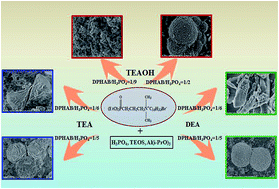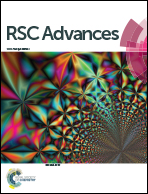Organophosphorous surfactant-assistant synthesis of SAPO-34 molecular sieve with special morphology and improved MTO performance†
Abstract
With the aid of self-designed organophosphorous surfactant [2-(diethoxylphosphono)propyl]hexadecyldimethylammonium bromide (DPHAB), SAPO-34s with various special morphologies have been hydrothermally synthesized by using tetraethylammonium hydroxide (TEAOH), diethylamine (DEA) and triethylamine (TEA) as templates, respectively. The synthesized SAPO-34s were well characterized by XRD, XRF, SEM, N2 adsorption–desorption, solid state NMR and NH3-TPD measurements. The status of DPHAB was also investigated by using FT-IR, 13C NMR, TG–DTA and 31P NMR measurements as well as density functional theory calculations. It is found that the addition of DPHAB changes the crystal morphology dramatically and the aggregation degree of the crystals increases with the rising DPHAB/H3PO4 ratio. Moreover, microporous templates play an important role in the synthesis of mesoporous SAPO-34. TEAOH, which has the strongest interaction energy with the CHA framework among the investigated templates, shows the best cooperating ability with an organophosphorous surfactant to direct the formation of nanosized and mesoporous SAPO-34. The prepared SAPO-34s showed improved catalytic properties in the methanol-to-olefins (MTO) reaction.


 Please wait while we load your content...
Please wait while we load your content...